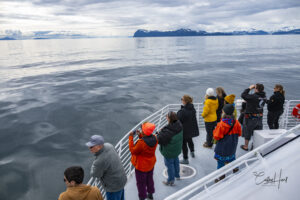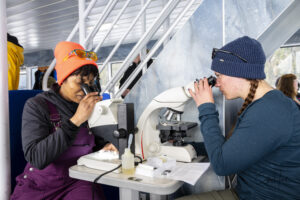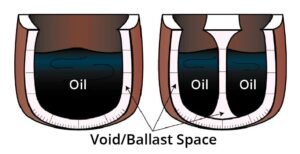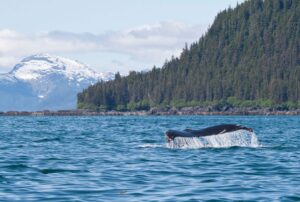 On May 1, Council volunteers and staff joined local high school and college students, educators, and other partners on a cruise to Bligh Reef, where the Exxon Valdez oil tanker ran aground in 1989.
On May 1, Council volunteers and staff joined local high school and college students, educators, and other partners on a cruise to Bligh Reef, where the Exxon Valdez oil tanker ran aground in 1989.
On board Stan Stephens’ Valdez Spirit, the students were immersed in learning about the marine environment and the effects of oil spills. Passengers were treated to the typical delights of Prince William Sound including glimpses of whales, views of sea lions, and the beautiful scenery.
The tour was put on by the Copper River Watershed Project, or CRWP, in collaboration with the Prince William Sound College, or PWSC. CRWP Program Director Kate Morse and PWSC Professor Amanda Glazier coordinated the event. Morse is also a member of the Council’s Information and Education Committee. Council members led activities and contributed their expertise on board.
Groups of students and adults rotated through learning stations over the course of the five-hour tour including conducting plankton “tows” to collect samples from the water, exploring plankton samples under microscopes, collecting water chemistry data, discussing marine navigation, and learning about marine oil spill response.
 Participants also had the opportunity to engage in an activity titled “Voices from the Spill,” which involved reading personal stories of the Exxon Valdez oil spill and its aftermath, and then respond through creative writing or art.
Participants also had the opportunity to engage in an activity titled “Voices from the Spill,” which involved reading personal stories of the Exxon Valdez oil spill and its aftermath, and then respond through creative writing or art.
Alyeska Pipeline Service Company generously provided a meal during the trip. Mixed groups of high school students, college students, and adults ate together and talked through a list of questions that prompted sharing about education and career pathways. In between learning activities, narration was provided about environmental, historical, and marine industry items of interest. Narrators included experts on board, such as trip leaders, the vessel captain, Council volunteers and staff, and staff from Alyeska’s Ship Escort Response Vessel System.
In addition to viewing the Valdez Marine Terminal and oil spill response equipment from the water, there was exciting tanker activity. The group observed two tankers at the terminal, an empty inbound tanker with its tug escort, and a laden outbound tanker with its two escort tugs including one tethered to the stern.
The Council helped fund this tour as part of its Youth Involvement Program, which strives to help build the next generation of environmental stewards for our region. The Bligh Reef Expedition was successful at getting local youth out into the environment of Prince William Sound to learn about ecology, oceanography, history, oil industry operations, and marine safety, all while connecting with local community members who work in associated fields.
Funds of up to $5,000 are available for educational projects related to our mission. Please contact Maia Draper-Reich if you would like to be notified when the next proposal period opens.





 On May 1, Council volunteers and staff joined local high school and college students, educators, and other partners on a cruise to Bligh Reef, where the Exxon Valdez oil tanker ran aground in 1989.
On May 1, Council volunteers and staff joined local high school and college students, educators, and other partners on a cruise to Bligh Reef, where the Exxon Valdez oil tanker ran aground in 1989. Participants also had the opportunity to engage in an activity titled “Voices from the Spill,” which involved reading personal stories of the Exxon Valdez oil spill and its aftermath, and then respond through creative writing or art.
Participants also had the opportunity to engage in an activity titled “Voices from the Spill,” which involved reading personal stories of the Exxon Valdez oil spill and its aftermath, and then respond through creative writing or art. At the Council’s May Board meeting, a draft resolution in support of voluntary speed reductions for oil tankers in Prince William Sound was presented by a concerned citizen. The Council has been studying the issue of vessel speed reductions to reduce whale strikes through the Scientific Advisory and Port Operations and Vessel Traffic System committees for over two years.
At the Council’s May Board meeting, a draft resolution in support of voluntary speed reductions for oil tankers in Prince William Sound was presented by a concerned citizen. The Council has been studying the issue of vessel speed reductions to reduce whale strikes through the Scientific Advisory and Port Operations and Vessel Traffic System committees for over two years.